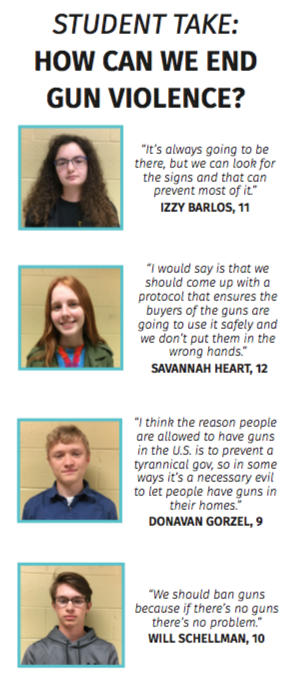Compromise is the Only Solution for Gun Laws
Applying restrictions to firearm is a polarizing issue, but finding a solution requires working together
Credit to Heeral Patel
(Illustration by Heeral Patel)
Published: May 3, 2018
 Our eyes pass over headlines covering the shootings involving law enforcement and those occurring in public places — schools, concerts, churches, movie theaters — while regular shootings in urban areas are largely ignored.
Our eyes pass over headlines covering the shootings involving law enforcement and those occurring in public places — schools, concerts, churches, movie theaters — while regular shootings in urban areas are largely ignored.
Whether or not we have personal ties to the gun debate, most people hold tight to their opinion on the issue. So tight, that many aren’t willing to understand those that disagree with them. As individuals who want the best for our country, our communities, it would be in our best interest to find a compromise.
There appears to be two sides: one pushing for change and another voicing caution so everything is not only funded, but also complies with the Constitution. Opinions are strong and diverse, making America’s complex relationship with guns difficult to navigate. Instead, we find walls dividing us and the people that we don’t agree with. We fall back on what feels safe, which unfortunately involves disdain for ideologies different from our own. A “with us or against us” mindset prevents us from hearing anything that doesn’t comply with our own beliefs.
The tendency to exaggerate the extremity of opposing views muddles the problem even more. People get hung up on their differences and demonize those whose views don’t match their own. They start the same fights again and again, preventing any progress to take place. Protecting the rights of responsible gun-owners doesn’t have to be the same as being lenient on potentially dangerous people. Advocating for gun regulations doesn’t have to be a violation to our liberties.
Nor should it.
To find a realistic solution we need to find a compromise. For that, people need to be willing to talk to each other about the issues, and this isn’t as far fetched as it may seem. A 2017 Pew Research study found 89 percent of gun-owners and 89.5 percent non-owners support preventing the mentally ill from purchasing firearms; 79 percent of gun-owners and 86.5 percent of non-owners support background checks for private sales and 83.5 percent of gun-owners and 85.5 percent of non-owners barring purchase for people on a no-fly or watch list. There are ideas we can agree on. Focusing on the similarities rather than differences can help build a solid base for us to work together to find the answer. Then, together we can move forward.
Studies conducted to analyze the effects of such regulations as well as find what causes violence in the first place would help provide a more holistic view of the situation, which can pave way for an effective solution by providing facts. We need to find out what’s causing the violence, but that’s nothing if we don’t discuss our views and understand each other’s logic, reasons and concerns.
How do we make sure everyone who has a gun handles it safely?
Where does funding come from for regulations?
Who’s responsible to teach gun safety?
How can we make sure that people who use a gun as a tool to protect themselves and others are not deprived of their rights, but still bar those that wish to use guns for malicious purposes?
It’s a complex problem, but the best way to solve it is through compromise. This doesn’t just apply to politicians. We face the debate in our daily lives through conversations in real life and online. Far too often our initial reactions may be an angry rebuttal, or just to ignore the opposing argument all together.
In these instances, it’s important we slow down our thought process, approach the conversation with an open mind and try to really understand the other person’s logic. Be respectful and listen. We need to focus on what we agree on to formulate a solution that we can all rally around and advocate for. Only then we can start taking the first steps to put a solution in place, one that takes everyone into account. It doesn’t have to be the end-all-be-all solution. It can be adjusted as we learn more about what works and what doesn’t, but this can at least give us a starting point.




![FHN Holds Annual Senior Night On Home Turf [Photo Gallery]](https://FHNtoday.com/wp-content/uploads/2024/10/IMG_0837-300x169.jpg)

![Troy Defeats Knights Varsity Football [Photo Gallery]](https://FHNtoday.com/wp-content/uploads/2024/10/Vfb_kwallace10.18-300x200.jpg)
![Day Three of Basketball Tryouts [Photo Gallery]](https://FHNtoday.com/wp-content/uploads/2024/11/Basketball-tryouts-PJaques-11.6-03-300x200.jpg)
![Knights Varsity Soccer Come Out Short To CBC [Photo Gallery]](https://FHNtoday.com/wp-content/uploads/2024/10/IMG_0391-300x200.jpg)


